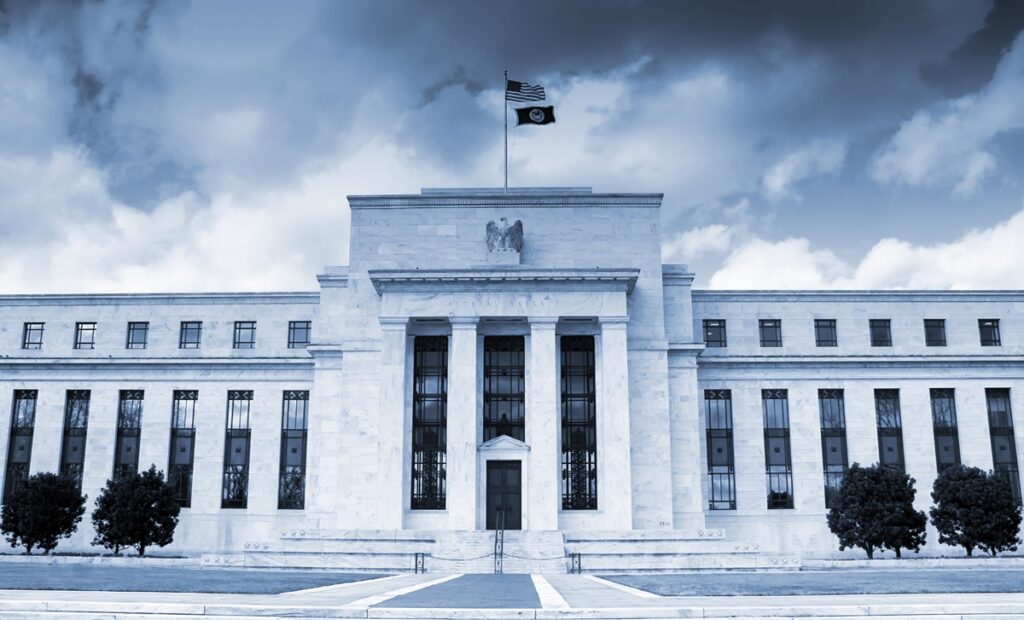Wednesday afternoon, the Federal Reserve Open Market Committee (FOMC) concluded its June meeting and decided to once again hold the federal funds rate steady at 4.25%-4.50%, amid an environment with tariff backlash, a rise in inflation, and a weakening economy. This marked the fourth consecutive meeting that the Fed held rates at 4.25%-4.50%.
“Although swings in net exports have affected the data, recent indicators suggest that economic activity has continued to expand at a solid pace. The unemployment rate remains low, and labor market conditions remain solid. Inflation remains somewhat elevated,” said the Fed in a post-meeting statement. “The Committee seeks to achieve maximum employment and inflation at the rate of 2% over the longer run. Uncertainty about the economic outlook has diminished but remains elevated. The Committee is attentive to the risks to both sides of its dual mandate. In support of its goals, the Committee decided to maintain the target range for the federal funds rate at 4.25%-4.50%. In considering the extent and timing of additional adjustments to the target range for the federal funds rate, the Committee will carefully assess incoming data, the evolving outlook, and the balance of risks. The Committee will continue reducing its holdings of Treasury securities and agency debt and agency mortgage‑backed securities. The Committee is strongly committed to supporting maximum employment and returning inflation to its 2% objective.”
Federal Housing Finance Agency (FHFA) Director William J. Pulte reacted to the Fed’s hold in rates with a series of social media posts, even calling for the resignation of Federal Reserve Chair Jerome Powell.
“Do your job Jerome Powell, and lower rates. If not, resign and let someone else realize inflation is DOWN and that Americans deserve lower rates. ENOUGH IS ENOUGH,” said Pulte on X just hours before the FOMC concluded its meeting.
Pulte followed up: “Funny thing is Jay Powell is talking right now about the housing market—he has no clue what he can do for the housing market. And he’s not listening to the people who help lead the housing market. Too Late needs to RESIGN.”
He concluded: “As Chairman of Fannie Mae and Freddie Mac, I can tell you that Jay Powell is hurting the housing market by being Too Late to lower rates. He needs to resign, effective immediately.”
Danielle Hale, Chief Economist for Realtor.com, stated: “Since the May Fed meeting six weeks ago, the job market has continued to hold steady, with unemployment still hovering just above 4% and employers adding jobs. Some of the recession concerns such as worries about their personal financial situation and the likelihood of losing a job have faded, helping push home purchase sentiment higher.”
What Lies Ahead
As for the direction of the economy, TransUnion, in its recent Q2 2025 Consumer Pulse study, found that 27% of U.S. consumers are now pessimistic about their household finances over the next 12 months. This marks a six-percentage point rise from Q4 2024 (21%), and a four-percentage point increase from a year ago (23%)—marking the highest level since TransUnion first began tracking this data point in Q1 2021.
Despite the rise in pessimism, 55% of consumers are optimistic about their household finances over the next 12 months–the same percentage as in Q2 2024. However, optimism has declined from 58% in Q4 2024. The youngest consumers surveyed–Gen Z and Millennials–remain most optimistic about future finances, at 67% and 64%, respectively. The findings are derived from a survey of 2,998 American adults between May 1-12, 2025. Nearly nine in 10 Americans (87%) reported some level of concern about the impact of current or possible tariffs on their household finances; 41% said they were very concerned. To that end, the Consumer Pulse study found that consumers now have an increasing interest in securing credit products.
“What does this mean for mortgage rates and the housing market,” asked Bright MLS Chief Economist Lisa Sturtevant. “The most important things to watch are inflation and the labor market, which are the economic indicators the Fed is tracking. If inflation comes down even slightly this summer while job growth remains steady, the Fed will cut rates in September. However, mortgage rates could fall even before the rate cut in response to these indicators. A decline in mortgage rate later this summer could give a jolt to the housing market, bringing buyers off the sidelines to take advantage of the dip in rates and expanded inventory.”
Mortgage Bankers Association (MBA) SVP and Chief Economist Mike Fratantoni added: “All in, a Fed on hold aligns with our forecast for little change in mortgage rates for the time being. MBA data continue to show modest increases in purchase application activity relative to last year, and we expect that trend to continue for the remainder of 2025 and into 2026.”
Trump Applies Pressure to Drop Rates
Federal Reserve Chair Powell recently met with President Donald Trump at the White House to discuss the state of the nation’s economy, employment, and inflation.
“Although swings in net exports have affected the data, recent indicators suggest that economic activity has continued to expand at a solid pace,” said the FOMC in a statement after the White House meeting. “The unemployment rate has stabilized at a low level in recent months, and labor market conditions remain solid. Inflation remains somewhat elevated.”
White House Press Secretary Karoline Leavitt confirmed the Powell did meet with Trump, telling reporters that the Fed’s summary was correct, but noting that Trump pushed Powell to lower rates.
“The President did say that he believes the Fed Chair is making a mistake by not lowering interest rates, which is putting us at an economic disadvantage to China and other countries. The President’s been very vocal about that, both publicly and now I can reveal privately as well,” Leavitt said in a briefing with the press.
Prior to Powell meeting with Trump, FHFA Director Pulte took to social media to call for a reduction in the federal funds interest rate.
“Jay Powell needs to lower interest rates—enough is enough. President Trump has crushed Biden’s inflation, and there is no reason not to lower rates. The housing market would be in much better shape if Chairman Powell does this,” said Pulte in a post on X.
Presidential Powers and the Federal Reserve
The Federal Reserve System performs five general functions to promote the effective operation of the U.S. economy:
- To promote maximum employment, stable prices, and moderate long-term interest rates in the U.S. economy;
- Promotes the stability of the financial system and seeks to minimize and contain systemic risks through active monitoring and engagement in the U.S. and abroad;
- Promotes the safety and soundness of individual financial institutions and monitors their impact on the financial system as a whole;
- Fosters payment and settlement system safety and efficiency through services to the banking industry and the U.S. government that facilitate U.S.-dollar transactions and payments; and
- Promotes consumer protection and community development through consumer-focused supervision and examination, research and analysis of emerging consumer issues and trends, community economic development activities, and the administration of consumer laws and regulations.
The President does not have direct control over the Federal Reserve’s policy decisions, but does have some influence. The President can nominate and appoint members of the Federal Reserve Board of Governors, including the Chair, which can influence the overall direction of the Fed, and can also voice their opinions about monetary policy. The President selects one member of the Board of Governors to serve as Chair of the Board, who also serves as the FOMC Chair. The FOMC, which makes the actual monetary policy decisions, is made up of all seven governors and five of the 12 regional Federal Reserve Bank Presidents. While the chair has one vote like the other governors, the structure is designed to prevent one individual, including the president, from dictating decisions and policies.
Fed to Reconsideration Processes
At the Federal Reserve Board’s recent Thomas Laubach Research Conference, a component of the Fed’s review of its monetary policy strategy, tools, and communication, Powell discussed how the FOMC will begin to analyze its framework, and the methods used to set interest rate policy and communicate it to the public, marking the first time the Fed will do so since 2020.
“We will reconsider aspects of our strategic framework in light of the experience of the last five years,” said Powell in his opening remarks. “We will also consider possible enhancements to the Committee’s [FOMC] policy communication tools regarding forecast uncertainty.”
The Fed mentioned it will examine the lessons of the 2021 inflation surge and path that global interests took after this surge in crafting its new framework.
“We provide our monetary policy framework in a document entitled the Statement on Longer-Run Goals and Monetary Policy Strategy, which we refer to as the consensus statement, the language in the opening paragraph, which has never changed, articulates our commitment to fulfilling our Congressional mandate and explains clearly what we’re doing and why that clarity reduces uncertainty, improves the effectiveness of our policy and enhances transparency and accountability,” explained Powell.
The Fed’s current monetary policy framework was crafted in an environment of low inflation and interest rates bordering the zero percent range. Under these conditions, the Fed keyed in more on the risk of being unable to stimulate the job market than on how to respond to inflationary concerns.







